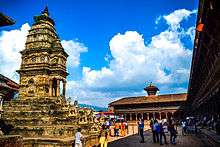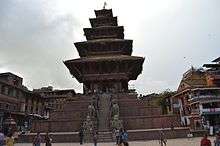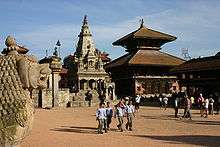Bhaktapur Durbar Square

Bhaktapur Durbar Square is the plaza in front of the royal palace of the old Bhaktapur Kingdom, 1400m above sea level.[1] It is a UNESCO World Heritage Site.
The Bhaktapur Durbar Square is located in the current town of Bhaktapur, also known as Bhadgaon,[1] which lies 13 km east of Kathmandu. While the complex consists of at least four distinct squares (Durbar Square, Taumadhi Square, Dattatreya Square and Pottery Square),[2] the whole area is informally known as the Bhakapur Durbar Square and is a highly visited site in the Kathmandu Valley.
Major attractions

55 window palace
The Palace of Fifty-five Windows(Pachpanna Jhyale Durbar) was built during the reign of the Malla King Yaksha Malla in 1427 AD and was remodeled by King Bhupatindra Malla in the 17th century. Among the brick walls, with their gracious setting and sculptural design, is a balcony of fifty-five windows, considered to be a unique masterpiece of woodcarving.It is also known as one of the oldest monument present in nepal.
Batsala Temple
Batsala Temple was the stone temple of goddess Batsala Devi that included many intricate carvings; however, it was most famous for its bronze bell, known to local residents as "the bell-of barking dogs " as when it is rung, dogs in the vicinity bark and howl. The colossal bell was hung by King Ranjit Malla in 1737 AD and was used to sound the daily curfew. It was rung every morning when goddess Taleju was worshiped. The bell remains intact; the temple was completely demolished by the 2015 Gorkha earthquake.
Statue of Bhupatindra Malla
The Statue of King Bhupatindra Malla in the act of worship can be seen on a column facing the palace. Of the square's many statues, this is considered to be the most magnificent.
Nyatapola Temple

Nyatapola in Newari language means five stories - the symbolic of five basic elements. This is the biggest and highest pagoda of Nepal ever built with such architectural perfection and artistic beauty.
Bhairava Nath Temple

The Bhairab Nath Temple is dedicated to Bhairava the most fierce and manifestation aspect of lord Shiva.
Golden Gate

Lu Dhowka (The Golden Gate) is said to be the most beautiful and richly moulded specimen of its kind in the entire world. The door is surmounted by a figure of the Hindu goddess Kali and Garuda (mythical griffin) and attended by two heavenly nymphs. It is embellished with monsters and other Hindu mythical creatures of marvellous intricacy. Percy Brown, an eminent English art critic and historian, described the Golden Gate as "the most lovely piece of art in the whole Kingdom; it is placed like a jewel, flashing innumerable facets in the handsome setting of its surroundings." The gate was erected by King Ranjit Malla and is the entrance to the main courtyard of the palace of fifty-five windows.[3]
Lion's Gate
The magnificent and beautiful gate was produced from artisans whose hands were cut off after finishing touch to them by the envious Bhadgoun king so that no more of such masterpiece would be produced again.[3] It is a very beautiful gate which attracts every human creatures.
Mini Pashupati Temple

The holy god Shiva temple, the mini pashupati, is believed to be built right in front of the palace after a Bhadgoan king dreamed of it.[3]
Temples
Erotic elephants temple — On the left just before the entrance way to the square is a hiti (water tank). A few steps before that but on the other side of the road, just 100m before the entrance way, is a tiny double-roofed Shiva-Parvati temple with some erotic carvings on its struts. One of these shows a pair of copulating elephants, in the missionary position: Kisi (elephant) Kamasutra.[4]

Ugrachandi and Ugrabhairab — Near the main gate at the west end, one can admire a pair of multiple-armed statues of the terrible god Ugrabhairab and his counterpart Ugrachandi, the fearsome manifestation of Shiva’s consort Parvati. The statues date back to 1701 A.D. and it is said that the unfortunate sculptor had his hands cut off afterwards, to prevent him from duplicating his masterpieces. Ugrachandi has eighteen arms holding weapons, and she is in the position of casually killing a (buffalo) demon. Bhairab has twelve arms and both god and goddess are garlanded with necklaces of human heads.
Rameshwar Temple — The first temple one notices on the right of the gate is Rameshwar, in front of Gopi Nath Temple which is a Gum Baja style. It is an open shrine with four pillars and it is dedicated to Shiva. The name Rameshwar comes from that it was Ram as an incarnation of Vishnu who had the original temple of Mahadev built at Rameshwar Temple in South India.[4]
Badrinath Temple — A small temple west of the Gopi Nath Temple locally known as Badri Narayan is dedicated to Vishnu and Narayan.[4]
Gopi Nath Temple — Two roofed pagoda style is the Gopi Nath Temple, attached to Rameshwar Temple that houses the three deities Balaram, Subhadra and Krishna. It is difficult to see the deities as the door remains mostly closed. The temple is also known as Jagannath, which is another from taken by Vishnu. Dwarika, also known as the Krishna Temple, houses three deities, left to right: Satyabhama, Krishna and Radha. Their images are carved in stone. In the month of Mangsir (November/December), the deities are placed in a palanquin and taken around the city.[4]
Kedarnath Temple — The terracotta made Shikara style temple is the Kedarnath (Shiva) Temple.[4]
Hanuman Statue — The entrance to the National Art Gallery is flanked by figure of Hanuman, the monkey god, who appears in Tantric form as the four armed Hanuman Bhairab. Hanuman is worshiped for strength and the devotion.[4]
Vatsala Devi Temple — Directly in front of the palace and beside the king’s statue and next to the Taleju Bell is the Vatsala Devi Temple. This Shikhara style temple is completely constructed in sandstone and is built upon a three-stage plinth, and has similarities to the Krishna temple of Patan. It is dedicated to Vatsala Devi, a form of the goddess Durga. The temple was originally built by King Jitamitra Malla in 1696 A.D. The structure that can be seen today, however, is reconstructed by King Bhupatindra Malla and dates back to the late 17th or early 18th century. Behind the temple is a water source called Dhunge Dhara and next to it stands the Chayslin Mandap.[4]
Layout

The Durbar Square proper houses the 55-window Palace which was constructed by King Jitamitra Malla and was home to royalty until 1769. It is now a national gallery. Close by is the Golden Gate which leads into Mulchok Court which is home to the Taleju Temple. This temple, like others in the main towns of the Kathmandu Valley, is dedicated to the goddess Taleju Bhawani and includes shrines to both the Taleju Bhawani and Kumari. Entrance to the temple is restricted and the living goddess strictly cannot be photographed.
The Durbar square is surrounded by spectacular architecture and vividly showcases the skills of the Newari artists and craftsmen over several centuries. The royal palace was originally situated at Dattaraya square and was only later moved to the Durbar square location.
Impact of earthquakes
The Durbar square at Bhaktapur was severely damaged by an earthquake in 1934 and hence appears more spacious than the others, in Kathmandu and Patan.[5]
Originally, there were 99 courtyards attached to this place, but now only 6 remain. Before the 1934 earthquake, there were 3 separate groups of temples. Currently, the square is surrounded by buildings that survived the quake.[5]
On 25 April 2015, another major earthquake damaged many buildings in the square. The main temple in Bhaktapur's square lost its roof, while the Vatsala Devi temple, famous for its sandstone walls and gold-topped pagodas, was demolished by the quake.[6]
Gallery
See also
References
- 1 2 Bhaktapur Durbar Square nepalandbeyond.com Archived January 8, 2013, at the Wayback Machine.
- ↑ Cultural History of Nepal By Bhadra Ratha Bajracharya, Shri Ram Sharma, Shiri Ram Bakshi
- 1 2 3 Bhaktapur Durbar Square. aghtrekking.com, Retrieved 27 October 2015
- 1 2 3 4 5 6 7 Bhaktapur Durbar Square, btdc.com.np. Retrieved 27 October 2015
- 1 2 Woodhatch, Tom (1999). Nepal Handbook (2nd ed.). Bath: Footprint Handbooks. ISBN 9781900949446. Retrieved 27 October 2015.
- ↑ "Nepal's Kathmandu Valley landmarks flattened by quake". BBC News. 26 April 2015. Retrieved 27 April 2015.
| Wikimedia Commons has media related to World Heritage Sites in Nepal. |
| Wikimedia Commons has media related to Bhaktapur Durbar Square. |
Coordinates: 27°40′19.86″N 85°25′42.43″E / 27.6721833°N 85.4284528°E


